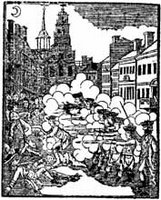“Three persons which I saw lay on the snow in the street”
 I’ve been tracking the experience of Ann Green on the night of 5 Mar 1770 through the testimony of people with her. Yesterday I left Ann in an upper room of the Boston Customs House where she lived, looking down on the increasingly violent crowd on King Street.
I’ve been tracking the experience of Ann Green on the night of 5 Mar 1770 through the testimony of people with her. Yesterday I left Ann in an upper room of the Boston Customs House where she lived, looking down on the increasingly violent crowd on King Street.
Customs employee Thomas Greenwood described the sight:
I went into the back room and got the key of the little drawing-room, being the lower west corner chamber, and went upSo Greenwood left. He went to the army’s main guard for help, but I can’t help but think that the three women felt he was deserting them just after saying the situation looked dangerous.
stairs, and Elizabeth Avery, Mary Rogers and Ann Green followed me into the room; we all looked thro’ the glass, I saw some persons standing by the centry-box striking with sticks, but did not see them hit any body, tho’ a number of persons were close by them; I told the women above mentioned that I would not stay, for I was afraid that the house would be pulled down, there being about forty or fifty persons consisting of men and boys…
Ann’s brother Hammond finished locking all the doors and windows below and then joined the young women in that “lower west chamber, next to Royal Exchange lane,” he testified. Elizabeth Avery later told the court:
I lived with Mr. Bartholomew Green at the Custom-house on the 5th of March last, and when the noise was in the street, before the house I went with [Hammond Green,] Nancy Green and Mary Rogers up into that chamber of the house, which is next to Royal-exchange-lane and right over the Sentry-box as it then stood, and from the west window in that room saw the party of soldiers come down from the Main-guard to the Sentry…The merchant Edward Davis (1718-1784) later described seeing “two women standing in the chamber of the Custom-house, which is next to Royal-Exchange-lane, with their hands under their aprons, in the posture of spectators.”
Hammond stated, “I…saw several guns fired in King-street, which killed three persons which I saw lay on the snow in the street, supposing the snow to be near a foot deep.” Avery said she “tarried in this room till the firing was all over, and the soldiers had returned from whence they came.” Then Hammond “let Eliza Avery out of the front door, and shut it after her.” The record doesn’t say why she was leaving the house where she lived.
Ann and Hammond’s father Bartholomew Green then came home. Hammond said they spoke in the kitchen:
he asked me what was the matter, I told him that there were three persons shot by the soldiers who stood at the door of the Custom-house; he then asked me where the girls were, I told him they were up stairs, and we went up together…Unfortunately, we don’t have any description from Ann Green of what she had experienced. She testified at one of the trials that followed, but the surviving record says only that she “confirmed in every particular the testimony of Elizabeth Avery, the preceeding witness.” So we have to guess what it was like to be in that room—watching the fight develop outside, wondering if the crowd would attack the house, not knowing where her brother John or others were.
And then the authorities came for her brother.
TOMORROW: The third murder trial to follow the Boston Massacre.

2 comments:
I'm having trouble imagining this scene. If the snow was a foot deep, how could the crowd move? Yes, Bostonians can walk in foot deep snow (see last winter) but it takes some effort. A large group of people would also tamp down the snow, but Hammond Green says he saw the bodies lay on the snow which he supposed was a foot deep? Was the snow shoveled in front of the sentry box? Or did the injured move off into a snow bank? Was he overestimating how much snow was on the ground?
Thanks for any insight you might have.
Love you blog.
A faithful reader
Given how King Street was one of the town’s busiest roads, and there were clearly a lot of people tramping around the sentry box outside the Customs House that night, and it wasn’t snowing up to the moment of the confrontation, I don’t think we can read Green’s comment as evidence there was a foot of fluffy snow on the ground. One possibility is that he was mistaken. More likely, I suspect that the winter's snow had been trampled and rolled and otherwise packed down—not plowed aside as we do today. So the bodies lay on top of some inches of hard-packed, not very white snow.
Post a Comment